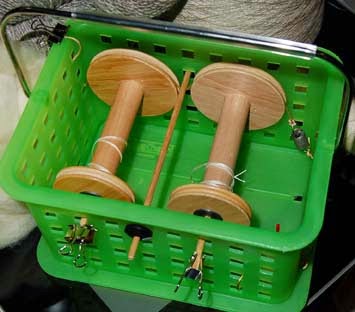I wrote and posted this article on the Greater Birmingham Fiber Guild blog in September 2014. I still like this project and you never know what will happen to a group blog so I'm saving most of that post here.
So, from 2014...
Text and photos by Mary Spanos
One of the unfortunate things about equipment being in storage rather than being loved and cared for in someone's home is that parts can go missing. The guild wheel had only one bobbin and no lazy kate. When I ordered two new bobbins I could have ordered a new lazy kate, too, but the cost of the bobbins and anything else that would be purchased would be passed onto the lucky person who would buy the wheel, and I didn't want to make the decision of what type of kate they would want. There are a lot of very different styles of kates available these days and I didn't want to make that choice for the new owner.
But, the new owner would need something to use as a lazy kate until they found the kate of their dreams, so Michael Spanos and I set to work making a kate out of things that we could find around our house and work rooms. The finished product works so well that I wanted to share the details with the rest of the guild, just in case someone else needs a new lazy kate.
Here it is, the new Spanos tensioned and portable lazy kate... Ta Da!
It is "built" in a green plastic box with a chrome handle, so it is ready to go from the living room to the porch, or to spinning study group meetings.
Michael and I enjoy making tools and some of the most fun projects are the ones where there is no plan, we wander around a hardware store or our house looking for something that will serve the purpose. This project was one of those.
I walked around the house with the two bobbins, looking for a box that was the right size to hold them. I was lucky to find this green plastic storage box that had holes all over every side and a shiny chrome handle. The holes made the construction process very easy.
Next, I found a small-diameter wooden dowel and cut 3 pieces so they fit across the box and stuck out a little. Two of the dowel pieces hold the bobbins, obviously, and the third piece is part of the brake system. I used rubber faucet washers and bind clips to hold the dowels in place (I used binder clips for the ends that would be pulled out to take a bobbin off or put one on).
Rubber faucet washers are my new favorite construction part, they are available at every hardware store and inexpensive. With the right size dowel (which you can find by taking a faucet washer to the selection of dowels and testing to find the right size dowel), they provide a snug hold while being easy to pull off and push back on.
The braking system. A tensioned lazy kate makes plying much easier than trying to ply while the bobbins fly forward and jerk back. If the bobbins feed the yarn to you smoothly, then you can concentrate on the important job of making the yarn that you want. Below you can see the simple braking system that we made inside the green plastic box.
Looking above left and below, you can see that there is a spring tied below the bobbin that tensions the gold colored nylon cord. The spring was formerly doing service as the brake spring on the Ashford Traditional spinning wheel, shown at the top of this post. When I replaced that tensioning system with the Peter Teal tensioning system, the spring was no longer needed there so I used it here.
The nylon brake cord goes from the spring, up and over the first bobbin, under the center dowel, up and over the second bobbin, and is threaded through the holes in the box from down low up to the top edge where it is secured with a binder clip.
The gold nylon cord came from the local HAM radio convention. I'm not sure what HAM radio operators do with it, but I use it for a lot of different things. You could use whatever type of cord or line that you use for the brake on your spinning wheel.
That is all there is to the functionality of this lazy kate, providing a place for the bobbins to rotate while the yarn is being pulled off, and providing a braking or tensioning system to regulate how fast the bobbins rotate.
Like many wheels the Ashford Traditional needs to be oiled, which results in the ongoing problem of keeping an oil bottle around while keeping it upright so the oil doesn't leak out. Since there was room in the lazy kate box, I added an oil bottle corral that I made from brass wire, which is available at hardware stores. I use brass wire a lot. For this wheel, I also used the same brass wire to make the hook part of the Peter Teal tensioner and to make a matching orifice hook. To make the the brass wire look a little less like brass wire from the hardware store, I hammer it with a jewelers hammer on a jewelers anvil after I have formed it into its final shape.
For the oil bottle corral, I made a "U" shaped piece with curls on the ends, that fits into the holes in the box, with the curly ends locking it into place.
That was it, back in 2014, the Spanos Tensioned Lazy Kate. I made another one of these for myself and still use it when a standard traditional wooden kate just won't do.








Comments
Post a Comment